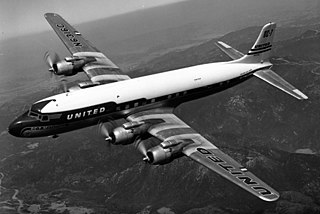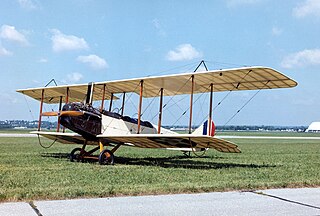
St. Pete–Clearwater International Airport is a public/military airport in Pinellas County, Florida, United States, serving the Tampa Bay Area. It is right on the northeast municipal boundary of Pinellas Park, 9 miles (14 km) north of downtown St. Petersburg, 7 miles (11 km) southeast of Clearwater, and 17 miles (27 km) southwest of Tampa.

The Lockheed Constellation ("Connie") is a propeller-driven, four-engined airliner built by Lockheed Corporation starting in 1943. The Constellation series was the first pressurized-cabin civil airliner series to go into widespread use. Its pressurized cabin enabled commercial passengers to fly well above most bad weather for the first time, thus significantly improving the general safety and ease of air travel.

Destin–Fort Walton Beach Airport is an airport located within Eglin Air Force Base, adjacent to the city of Valparaiso and near the cities of Destin and Fort Walton Beach, in Okaloosa County, Florida, United States. The airport was previously named Northwest Florida Regional Airport until February 17, 2015, and Okaloosa Regional Airport until September 2008.
Panama City–Bay County International Airport(IATA: PFN, ICAO: KPFN, FAA LID: PFN) was a public airport 3 miles (4.8 km) northwest of Panama City, in Bay County, Florida. It was owned and operated by the Panama City–Bay County Airport and Industrial District. All airline services moved to the Northwest Florida Beaches International Airport on May 22, 2010, but the airfield was open to general aviation aircraft until October 1, 2010. The grounds will eventually be turned over to LUK-MB1 LLC, which plans to remove the runways and build homes, shops, walking trails and a marina.

Melbourne Orlando International Airport is a public airport 1.5 miles (2.4 km) northwest of downtown Melbourne, in Brevard County, Florida, United States, and 50 miles southeast of Orlando, located on central Florida's Space Coast. The airport is reached by NASA Boulevard. It is governed by a seven-member board which is appointed by the Melbourne City Council and the private sector. The airport budget is part of the Melbourne municipal budget; the airport receives no local tax dollars. The projected expenses for 2010 were $14.1 million. The executive director of the airport is Greg Donovan, A.A.E.

Huntsville International Airport is a public airport and spaceport ten miles southwest of downtown Huntsville, in Madison County, Alabama, United States.

The Douglas DC-7 is an American transport aircraft built by the Douglas Aircraft Company from 1953 to 1958. A derivative of the DC-6, it was the last major piston engine-powered transport made by Douglas, being developed shortly after the earliest jet airliner—the de Havilland Comet—entered service and only a few years before the jet-powered Douglas DC-8 first flew in 1958. Unlike other aircraft in Douglas's line of propeller-driven aircraft, no examples remain in service in the present day, as compared to the far more successful DC-3 and DC-6.

The Douglas B-23 Dragon is an American twin-engined bomber developed by the Douglas Aircraft Company as a successor to the B-18 Bolo.

The Curtiss Robin, introduced in 1928, was a high-wing monoplane built by the Curtiss-Robertson Airplane Manufacturing Company. The J-1 version was flown by Wrongway Corrigan who crossed the Atlantic after being refused permission.

ValuJet Airlines, later known as AirTran Airlines after joining forces with AirTran Airways, was an ultra low-cost U.S. airline, headquartered in unincorporated Clayton County, Georgia, that operated regularly scheduled domestic and international flights in the Eastern United States and Canada during the 1990s. The company was founded in 1992 and was notorious for its sometimes dangerous cost-cutting measures. All of the airline's planes were purchased used from other airlines; very little training was provided to workers; and contractors were used for maintenance and other services. The company quickly developed a reputation for safety issues. In 1995, the military refused ValuJet's bid to fly military personnel over safety worries, and officials at the FAA wanted the airline to be grounded.
Fort Lauderdale Executive Airport is a general aviation airport located within the city limits of Fort Lauderdale, in Broward County, Florida, United States, five miles (8.0 km) north of downtown Fort Lauderdale. It is a division of the Transportation and Mobility Department of the City of Fort Lauderdale.

Daytona Beach International Airport is a county-owned airport located three miles (5 km) southwest of Daytona Beach, next to Daytona International Speedway, in Volusia County, Florida, United States. The airport has 3 runways, a six-gate domestic terminal, and an international terminal. Daytona Beach is the headquarters of Embry-Riddle Aeronautical University.
North Palm Beach County Airport, also known as North County Airport, is an uncontrolled (non-towered) general aviation airport located 12 nautical miles northwest of West Palm Beach off the Bee Line Highway in Palm Beach Gardens, Florida. The airport is owned by Palm Beach County and operated by the Palm Beach County Airports Department.

Miami-Opa Locka Executive Airport is a joint civil-military airport located in Miami-Dade County, Florida 11 mi (18 km) north of downtown Miami. Part of the airport is in the city limits of Opa-locka. The National Plan of Integrated Airport Systems for 2011–2015 called it a general aviation reliever airport.
North Perry Airport is a public airport in the City of Pembroke Pines, 5 miles (8 km) west of the central business district of Hollywood, in Broward County, Florida, United States. It is also known as Hollywood North Perry Airport, hence the HWO codes. The airport is owned by the Broward County Aviation Department. It is a general aviation airport devoted to private and business light aircraft activity.

Aluminum Overcast, B-17G-105-VE, s/n 44-85740, civil registration N5017N, as of November 2022, is one of only nine presently airworthy Boeing B-17 Flying Fortresses of the 48 complete surviving airframes in existence. It never saw combat, and it escaped the fate of many aircraft that were scrapped after World War II. It is owned by the Experimental Aircraft Association (EAA), and, as of 2022, it is still touring the United States and Canada offering flight experiences.

Opa-locka West Airport was a county-owned public airport located 12 miles (19 km) northwest of the central business district of Miami, a city in Miami-Dade County, Florida, United States. It covered an area of 420 acres (170 ha) which contained two asphalt paved runways: 9/27 measuring 3,000 x 60 ft and 18/36 measuring 3,000 x 60 ft.

The Standard J is a two-seat basic trainer two-bay biplane produced in the United States from 1916 to 1918, powered by a four-cylinder inline Hall-Scott A-7a engine. It was constructed from wood with wire bracing and fabric covering. The J-1 was built as a stopgap to supplement the Curtiss JN-4 in production.

Coast Guard Air Station Miami is an Air Station of the United States Coast Guard located at Opa-locka Executive Airport in Opa-locka, Florida. The station operates the HC-144 Ocean Sentry maritime patrol aircraft and the MH-65 Dolphin helicopter.















